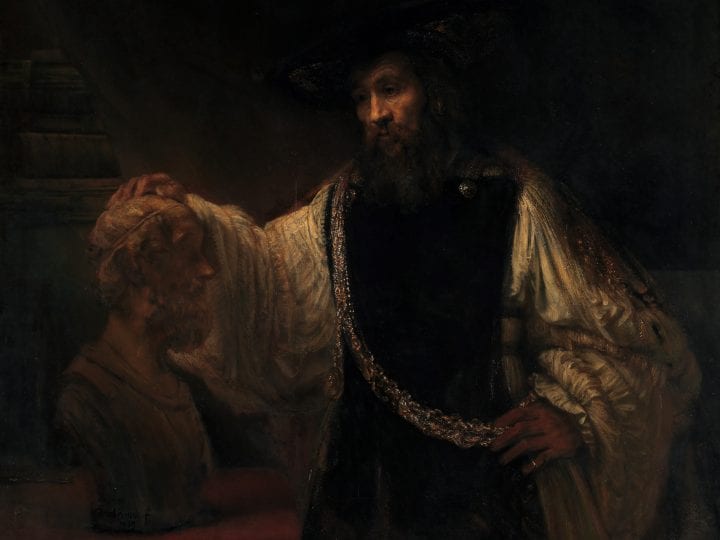In his 1637 book, De pictura veterum, Franciscus Junius makes the case that natural talent rather than learned theory plays the greater part in creative achievement, a view he grounds in the ancient literary treatise Peri hypsous, traditionally attributed to Longinus and known since the eighteenth century as On the Sublime. By the 1650s, Junius’s discussion of the Longinian sublime, or grace, would have taken on new significance in light of the growing interest, in and beyond the Dutch Republic, in codified rules—much of it revolving around Aristotle’s Poetics. Against this trend, Rembrandt produced his Aristotle with a Bust of Homer of 1653 (New York, Metropolitan Museum of Art). In it he presents Aristotle—author of the earliest extant and most influential work of literary theory—at a moment of recognition that his rules are ultimately insignificant in comparison to natural genius, which his forebear Homer above all others possessed. Rembrandt thus pictorializes the sublime and, with the heavy gold chain draped across Aristotle’s chest, articulates the view attributed to the artist by later critics: that in pursuit of the height of excellence in art and literature one ought to bind oneself to one’s natural gifts, rather than to theoretical rules. Rembrandt does not illustrate Junius’s text, but may have found in the scholar’s invocations of Longinus an affirmation of his own long-held understanding of genius.
In memory of Walter Liedtke
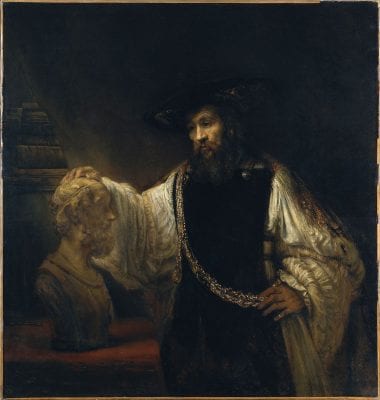
Adhering to the practice he had adopted, he was prepared to challenge our rules of art, of anatomy, human proportions and perspective, arguing against the use of antique sculptures, against Raphael’s draftsmanship and the systematic training of young artists, and against the academies, so vital to our profession, asserting that one should bind oneself solely to nature and observe no other rules.
—Joachim von Sandrart, Teutsche Academie (1675)1
These well-known remarks about Rembrandt’s supposed rejection of the “rules of art” represent not the anachronistic view of a distant commentator, but instead, as Perry Chapman and Eric Jan Sluijter have demonstrated, the informed (if exaggerated) reaction of a fellow painter to the eccentric artistic persona that Rembrandt in fact crafted and the naturalistic mode of representation he indeed practiced and promoted in opposition to established standards of idealization.2 Sandrart’s words also reflect, more broadly, a longstanding debate about the place of rules in artistic and literary achievement, to which, as I shall propose, Rembrandt himself contributed with his Aristotle with a Bust of Homer of 1653 (fig. 1).3 Throughout the seventeenth century, Dutch writers addressed the question of the relative importance of innate ability (“nature”) and learned theory or rules (“art”), whether with regard to the visual or literary arts, or, as was often the case, with implications for both. An early and especially illuminating example is Franciscus Junius’s discussion in his book De pictura veterum (The Painting of the Ancients), published in Latin in 1637 and in English and Dutch translations, carried out by the author himself, in 1638 and 1641, respectively.4 In this text—not a source for Rembrandt but an indicator of the ideas and ideals of his contemporaries—Junius makes the case that natural talent plays the more significant part in producing truly great art, a view he grounds in Longinus’s Peri hypsous, in which sublime achievement is largely attributed to in-born (or divinely bestowed) genius unfettered by artificial rules.5 Analyzing Rembrandt’s picture in relation to Junius’s invocations of the Longinian sublime and the broader nature versus rules debate, I interpret the painting as a narrative in which Aristotle, author of the earliest extant and most influential work of literary theory, recognizes that his rules are ultimately insignificant in comparison to innate genius, which his forebear Homer above all others possessed.6 In this work Rembrandt pictorializes the sublime and, with the golden chain that hangs across the philosopher’s chest, articulates the view that Sandrart would later attribute to the artist: that in pursuit of the height of excellence in creative achievement, one ought “to bind oneself” to nature—meaning one’s natural gifts—rather than to codified rules.
Although destined for the Sicilian nobleman Antonio Ruffo, Aristotle with a Bust of Homer represents, as Julius Held established in 1969 in his seminal study of the picture, a subject of Rembrandt’s own devising—one that is unique in the history of art and that relates, naturally, to the artistic and intellectual climate of his own milieu.7 A letter of June 19, 1654, indicates that the picture, reliably inscribed 1653, left Amsterdam nearly six months after its latest possible completion.8 The work therefore most likely remained for a significant period of time in the artist’s studio, where it could have enjoyed an audience composed of fellow Dutch artists and art lovers, among them the amateur poet and playwright Jan Six, whom Rembrandt portrayed in 1654.9 In any case, there is no evidence that its subject was predetermined by or even conveyed in advance to Ruffo, whose household first registered it on September 1, 1654, as “a half-figure of a philosopher made in Amsterdam by the painter Rembrandt (apparently Aristotle or Albertus Magnus).”10 In a letter of November 1662, however, Ruffo explicitly referred to the work as the “Aristotile,” making clear that by this point he had gained clarity about what it represented, presumably through exchanges about the two additional paintings Rembrandt sent to Ruffo in 1661: Alexander the Great (lost11) and Homer (The Hague, Mauritshuis).12
The patron’s initial uncertainty about the subject is understandable given the small but varied visual tradition surrounding the philosopher’s portrayal. Yet, as Walter Liedtke demonstrated in 2004, one tradition called for his representation with a beard, long hair, hat, and, according to at least one extant work—Joos van Wassenhove’s Aristotle, part of the series of famous men he produced for the ducal palace of Federico da Montefeltro at Urbino in the 1470s (fig. 2)—a ring on the end of a finger and a raised right arm.13 Whether Rembrandt was aware of this work through a drawing or copy or knew another like it, the resemblance between it and his own representation strongly suggests that he made a distinct effort to make Aristotle recognizable. Accordingly, his choice of protagonist bears direct significance on the meaning of the picture. The one weakness of Held’s highly influential and still prevailing view that the painting depicts a conflict between eternal fame (represented by Homer) and worldly success (represented by the chain, in his view a collar of service bearing the portrait of Alexander the Great) is that for such a program, other historical, even anonymous, figures might have served equally well.14 Instead we must seek an understanding in which Aristotle, his admiration for Homer, and thus his identity as a literary theorist are central.
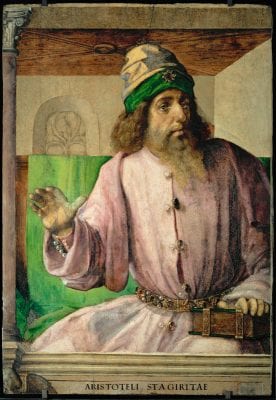
Held’s analysis of the Aristotle eclipsed another published one year earlier by Jan Emmens, who in fact associated the painting with nature and theory.15 Emmens’s interpretation appeared as part of his major study of Rembrandt’s reception, in which he proposed that the artist was not antipathetic to rules but simply unaware of the particular “classicistic” principles Sandrart and others anachronistically accused him of rejecting.16 According to Emmens, until the 1670s these rules were unknown in the Dutch Republic, and there existed no perception of opposition between nature and theory; instead the artist and his contemporaries believed in the equal importance of nature, teaching, and practice—an ancient triad allegorized in Emmens’s view by Rembrandt’s picture, with Aristotle representing teaching, or doctrine, Homer nature, and Alexander, by virtue of his military exploits, practice.17 This triad, however, appears in extremely few seventeenth-century Dutch sources.18 Instead, writers of the period—Huygens, Junius, Vossius, Vondel, Vos, and Pels, among others—frequently discussed natural talent and learned rules in contrasting, not complementary, terms. Even if none of them could truly believe solely in one or the other and as much as their remarks were informed by those of their ancient forebears, they were not merely repeating a common topos but earnestly enquiring into what produces great art and literature. This discourse coincided with the increasingly frequent publication and translation of ancient treatises on rhetoric and literature and, by the 1650s, the growing embrace of theoretical principles by contemporary poets and dramatists. Instead of viewing Rembrandt’s picture as an illustration of a static concept, I frame it as a contribution to—even against—this trend in contemporary thinking about the place of rules in creative pursuit.
The nature versus rules debate indeed played out most visibly in the later part of the century, specifically in the writings of Jan Vos and Andries Pels. In the preface to the printed edition of his 1667 version of Medea, entitled “Aan de Beminnaars van d’oude en nieuwe Tooneelspeelen,” Vos directly questioned the utility—for ancient and contemporary practitioners—of Aristotelian and Horatian literary theories.19 Vos’s sentiments were in direct opposition to those of Pels, who in 1669 founded a literary society in Amsterdam, aptly named Nils volentibus arduum (“With will, nothing is impossible”), to promote those authors’ treatises and the adherence to classical doctrine more broadly. Pels also addressed the question explicitly in 1677 in his free translation of Horace’s Ars poetica, in which he frequently makes reference to contemporary poetry and responds directly to Vos.20 Here Pels acknowledges that those whom the Muses do not favor cannot compensate entirely through study and practice but emphasizes that so too is achievement impossible with an “uncivilized mind” and that doctrine must help nature “before one can obtain a place amongst the famous ranks of the greatest poets.”21 He concludes that “one is not born with art.”22 He reiterates these views in his Gebruik, én misbruik des tooneels (Use and Abuse of Theater) of 1681, in which he famously characterizes Rembrandt as a rule breaker.23
That there was already a debate under way much earlier in the century—and that Rembrandt was already insinuated within it—is clear from Constantijn Huygens’s vehement discussion of natural talent in the memoir he wrote between 1628 and 1631.24 In it he questions the value of treatises on oratory, arguing that any theory or lessons beyond the most basic fundamentals are redundant, even harmful, to natural talent, to which all clear and compelling expression is owed.25 Similarly, of the young Rembrandt and Jan Lievens, he comments that these artists owe nothing to their teachers and that even without their lessons they would have been seized by the urge to paint and reached the same heights.26
In De pictura veterum, Junius offers an extensive treatment of the question. On one hand he celebrates and promotes theory, freely applying ancient principles of rhetoric and poetry to painting. Yet he ultimately identifies natural talent as the chief source of artistic perfection—the endowment of a picture with an indefinable, special quality that succeeds in moving the beholder. To refer both to this perfection of art and to an individual’s capacity to produce it, he uses the term grace (gratie and occasionally bevalligheydt in the Dutch edition, gratia, venustas, and ingenio in the Latin).27 While he draws from Cicero, Quintilian, Pliny, and Plutarch, all of whom speak of an indescribable quality of rhetoric or art, he is informed most substantially by Longinus’s discussion of the sublime (hypsous, literally height)—the pinnacle of achievement that brings human endeavor closer to the work of prophets and gods and results in a powerful effect that “sways every reader whether he will or no.”28 What distinguishes his remarks, and in turn Junius’s, is the emphasis on the direct relationship between the excellence of the work and the character, or spirit, of its maker—effectively an articulation of the modern concept of creative genius.29
Longinus himself believes in the combination of natural ability and rules (his treatise, after all, largely concerns technique), but he emphasizes that it is from the former that arise the two most important sources of sublimity (the capacity to conceive great thoughts and the compelling treatment of emotions), and he is adamant that rules must not limit or constrain genius.30 Drawing a contrast between flawless but mediocre practitioners on the one hand and erring but great poets on the other, he praises the latter—Homer chief among them—and upholds as the highest quality of a writer “that impetuous, that god-gifted genius, which chafed against the restraints of law.”31
In equating grace with the Longinian sublime, Junius employed a term that had deeply rooted religious meaning and, in the Dutch Republic in the early years of the seventeenth century, especially charged associations.32 The nature of divine grace was one of five articles around which the conflict between Remonstrants and Counter-Remonstrants centered, a conflict Junius experienced firsthand during his brief employ as a minister at Hillegersberg in 1617.33 Both sides believed that grace was bestowed solely and freely by God and that it cannot be earned, but while the former understood man to have been allotted the free will to accept or refuse grace, the latter embraced a strict definition of irresistible grace, which, according to the Counter-Remonstrance of 1611:
works so powerfully in the hearts of God’s elect, that He illumines their minds, transforms and renews their wills, removing the heart of stone and giving them a heart of flesh, in such a manner that by these means they not only receive power to convert themselves and believe but also actually and willingly do repent and believe.34
Sixteenth-century Italian writers had, however, already established grace as a personal attribute and aesthetic quality.35 In his highly influential Libro del Cortegiano (1528), Baldassare Castiglione defines grazia as the overarching quality of charm and ease to which the courtier must aspire, particularly with regard to his eloquence as a speaker.36 For Castiglione, grace can be studied and learned, but, as he famously writes, all signs of effort must be masked by “a certain nonchalance” (sprezzatura), such that one’s orations will seem to be “springing rather from nature and truth than from study and art.”37 Cesare Ripa, however, in his Iconologia (first published 1593) explicitly identifies grace as a natural gift. His entry on Gratia describes a beautiful woman wearing pearls that “shine and please as a rare and secret gift of nature, like grace, which is a certain special charm in men that moves and ravishes the mind to love, and by stealth engenders liking and benevolence.”38 Vasari, too, in his Vite (1550/68), asserts that grazia cannot be taught. Applying the concept of grace to painting, he refers to a quality of the artist’s performance akin to virtuosity: characterized by facility, boldness, and an absence of laboriousness and excessive study.39 He writes: “Very great is the obligation that is owed to Heaven and to Nature by those who bring their works to birth without effort and with a certain grace which others cannot give to their creations either by study or imitation.”40
Junius inherited these definitions of grace, but through his direct study of Peri hypsous he gives it new significance, ultimately formulating a new definition of artistic genius. Introducing the term in the first of the three books that comprise De pictura veterum, Junius frames grace as the ultimate goal of artistic endeavor, that which distinguishes a great master or “perfect Artist” and brings him “everlasting fame.”41 Here he follows Longinus’s characterization of the sublime as the supreme height of achievement, by which “the greatest poets and prose-writers have gained eminence, and won themselves a lasting place in the Temple of Fame.”42
Interwoven with Junius’s discussion of grace throughout the three books are remarks about natural ability and rules.43 Like Longinus, he maintains that both are necessary, at one point quoting the ancient theorist’s own remark that “perfection consisteth in a mutuall coherence of these two.”44 Nevertheless, Junius repeatedly asserts the greater importance of nature, writing in Book 1, for example, that “nature can doe much without Doctrine, where Doctrine on the contrary cannot be without Nature.”45 In the same passage, he directly addresses the subject of grace with regard to natural inclination, writing that “every Artificer hath a peculiar Grace in his works, agreeing with the constitution of his nature.”46 Later Junius, again quoting Longinus, emphatically states that “magnificent thoughts come by nature, and cannot be taught.”47 In the same section he makes the significant point that grace is the domain of “great minded men” who are “of an exceeding great spirit, or at least upon all occasions entertaine great thoughts, and stately imaginations.”48 In a similar vein, he also excuses errors made by great practitioners, writing that “somthing must be indulged unto the wits of great Masters” and offers as an example Homer, who, according to Horace, “doth somtimes slumber and oversee himselfe.”49
It is in the third book that Junius presents a sustained analysis of grace, equating it with the sublime. In chapter 6, he offers a definition that directly echoes Longinus’s characterization of the sublime as the culminating effect of excellence in five distinct areas (in Junius’s case, Invention, Proportion, Color, Life, and Disposition):
The consummation of a picture consisteth chiefely therein, that these five heads concurring, and lovingly conspiring, should breath forth a certain kinde of grace, most commonly called ‘the aire of the picture:’ which in it selfe is nothing else but a sweet consent of all manner of perfections heaped up in one piece: the best collection of the best things.50
Reiterating that grace “readily and freely proceeding out of the Artificers spirit, cannot be taught by any rules of art: no more can assiduity of importunate studies helpe us to it,” Junius warns against “an unseasonable and over curious nicenesse of studying.”51 Here citing Plutarch, he again names Homer, and other poets and painters, in order to contrast belabored effort with the ease and freedom that characterizes true grace:
Plutarch doth likewise make a distinction betweene the fore-mentioned Grace and this same bold Facilitie: “the verses of Antimachus,” sayth he, “and the pictures of Dionysius…seeme to be forcibly expressed and too much belaboured: but Nichomachus his pictures and Homer his verses have this also besides all the other efficacie and grace which is in them, that you would thinke them made out of hand with much ease.”52
These remarks recall another Junius makes earlier in his text, in Book 2, where he, once again drawing from Longinus, encourages negligence, writing that “it addeth a singular grace to the worke, that there should sometimes appeare a certaine kinde of neglect [een sekere soorte van onachtsaemheyd] in most excellent Pictures [gheestighste schilderijen].”53 In that passage, his use of the term grace (bevalligheydt in the Dutch edition) comes closer to Castiglione’s discussion of sprezzatura and seems to refer to an artist’s or poet’s virtuosity, but in his discussion in Book 3 Junius makes clear that his understanding of grace goes beyond the illusion of ease to denote a quality of art with an effect beyond words and a source beyond effort and rules:
Pictures which are judged sweeter then [sic] any picture, pictures surpassing the apprehension and Art of man, workes that are sayd to be done by an unspeakable way of Art, delicatly, divinely, unfeisably, etc. insinuate nothing els but that there is something in them which doth not proceed from the laborious curiositie prescribed by the rules of Art, and that the free spirit of the Artificer marking how Nature sporteth her selfe in such an infinite varietie of things, undertooke to doe the same.54
Junius thus directly opposes the rules of art and the free spirit of the artist.
By 1653, this discussion of grace would have taken on new significance in light of the growing interest in codified rules in and beyond the Dutch Republic, much of it revolving around Aristotle’s Poetics. The publication in 1643 of a revised edition of Daniel Heinsius’s 1610/11 Latin translation of and commentary on the Poetics and in 1647 of Gerardus Vossius’s monumental study of the ancient text had international impact, spreading a refined understanding of Aristotelian literary theory throughout Europe.55 The greatest Dutch playwright of the period, Joost van den Vondel, in consultation with Vossius, had already shown an interest in Aristotelian drama as early as 1639 and would continue to refer to the ancient philosopher’s treatise for his work, even citing his precepts in the foreword to his 1659 tragedy Jeptha.56 Rembrandt himself would have the opportunity in 1648, if not before, to become familiar with the strictures of Aristotelian dramatic theory, when he produced the etched frontispiece for Jan Six’s Medea, as pure an Aristotelian tragedy as had ever been written.57 While Vondel’s own attitude toward theory cannot be characterized so simply—he was never a pedantic follower of rules and his adaptation of ancient theory was not an end unto itself—he nonetheless played a role in promoting poetic theory through his plays, as well as through his Aenleidinge ter Nederduitsche dichtkunst of 1650 and his 1654 translation of Horace’s Ars poetica, in which he acknowledges the “nurture of rules.”58 Thus the work of Andries Pels in and after the late 1660s did not initiate so-called “classicistic literary theory” in the Netherlands but rather developed and expanded an effort some years in the making.59
Against this trend Rembrandt produced his Aristotle with a Bust of Homer. Just as knowledge of Aristotle’s Poetics and likewise the philosopher’s reputation as a literary theorist was at this moment as widespread as it ever had been, the Homeric epics, long familiar through their circulation in Latin translation, were widely read by Dutch audiences. By 1611 the entirety of the Odyssey and portions of the Iliad, along with ancient accounts of the poet’s life, had been translated into Dutch, and in the 1650s new Dutch translations of both of his epics were undertaken.60 Homer himself was a long-standing paragon of natural or God-given genius—one who occasionally erred and broke rules, as Longinus, Horace, Junius, and various other ancient and early modern writers noted—and he was often portrayed as a divinely inspired poet-seer. In Raphael’s Parnassus, for example, Homer raises his blind eyes to suggest the heavenly source of his gift. This composition was widely known through Marcantonio Raimondi’s engraving, which served as the basis for Rembrandt’s own 1652 drawing of Homer for Jan Six’s album amicorum.
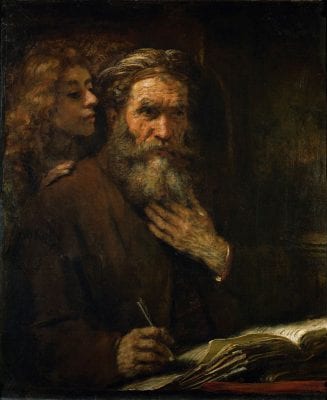
The rare joint appearance of Aristotle and Homer in Rembrandt’s painting would have undoubtedly brought to mind their opposing associations with theory and with genius. Moreover, in the Poetics itself, Aristotle grapples with the question of nature and rules as concerns Homer, observing his “transcendent excellence” and even asking whether his perfection stems “from art or natural genius.”61 Addressing this tension between Aristotle’s effort to codify literary achievement into a set of principles and his understanding of Homer’s natural gifts, Rembrandt constructs a narrative in which the philosopher is overcome by the poet’s genius and recognizes the limitations of his own rules. Appropriately he portrays a physical experience, a direct encounter between poet and theorist. Aristotle is not reading Homer’s epics but standing before and touching the bust, which, rendered with loose brushstrokes and warm tones, looks almost like sculpture come to life—as if he were in the poet’s actual presence. His expression and his gaze beyond the bust convey the overwhelming thoughts and emotions—the transport of the mind—that this encounter has inspired, while the warm light that appears to move across his face is suggestive of revelation.62 In all of these regards, Rembrandt’s presentation of Aristotle anticipates his Saint Matthew and the Angel of 1661 (fig. 3). Like the saint who experiences divine illumination—receiving the word of God through the angel who whispers in his ear and physically touches his shoulder—the philosopher experiences awe at Homer’s genius and its God-given source. Aristotle’s is not a religious encounter, but the artist employs the same pictorial language to represent the sublime.
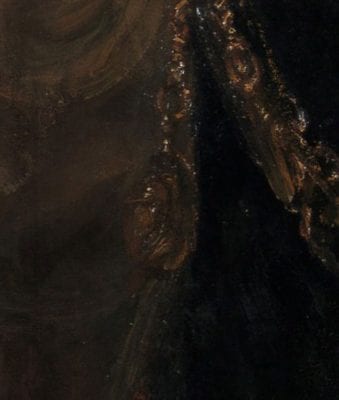
Rembrandt further pictorializes the experience of the sublime with the gold chain. As Christian Tümpel elucidated, one of Rembrandt’s chief pictorial tactics was to take a highly symbolic element and work it into his composition as naturally and plausibly as possible—to name an obvious example, the gilt Cupid sculpture that alludes to bound love in the Danaë (St. Petersburg, State Hermitage Museum).63 In my view, the chain in the Aristotle is another, more complex example of this practice. On one level it is, as Held demonstrated, a collar of service bearing the portrait medallion of Alexander the Great, whom Aristotle once served as tutor. (The fact that Rembrandt subsequently painted a Homer and an Alexander to join the Aristotle in Ruffo’s collection supports this. In addition, similar chains with medallions appear in a number of works by Arent de Gelder, where they clearly indicate a figure’s service to a ruler.64) At the same time, the ambiguity of the portrait on the medallion (fig. 4), which has continually given rise to debate about whether it represents Alexander or Minerva, is in my view deliberate—not a misunderstanding of Greek coins that feature the helmeted head of Minerva (or Athena) on one side and Alexander’s name on the other (fig. 5) but a clever allusion to their dual imagery.65 In Rembrandt’s picture, the medallion is plausibly incorporated into the picture as a portrait of Alexander, but it also operates metaphorically as a representation of Minerva, goddess of wisdom and protector of the liberal arts, who bestows on the poet divine inspiration and genius. Notably, in his book Junius associates Minerva with in-born talent, quoting Cicero’s remark that “nothing can be decent and comly in spight [meaning in opposition to] (as the common saying is) of Minerva, that is, our nature not giving way to it.”66
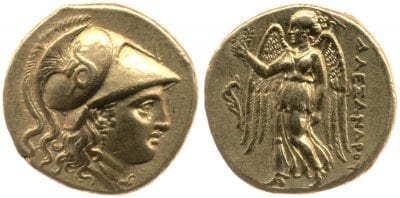
This understanding of the medallion permits association of the chain directly with grace and with positive connotations of captivation and bondage. A few lines before his invocation of Minerva, chains serve Junius as a metaphor for the overwhelming power of grace:
Having now seene alreadie wherein the chiefe comelinesse of Grace doth consist, and how by a glorious conquest it doth sweetly enthrall and captivate [in the Dutch edition, “soetelick gevetert ende gevangen houdt”] the hearts of men with the lovely chaines [in the Dutch, “de helde,” an archaic term for bondage] of due admiration and amazement.67
In Italy viewers of Rembrandt’s picture came to understand the chain in precisely these terms. As Xavier Salomon and Helen Langdon have shown, in 1673, twenty years after Rembrandt painted the Aristotle, the Italian artist Giacinto Brandi sent to Antonio Ruffo a now lost depiction of an artist at work on a painting of the giant Tityus chained to a rock.68 With regard to this work, which Ruffo understood to have been produced in direct emulation of Rembrandt’s Aristotle, Brandi expressed in a letter to his patron that just as Tityus was chained, so he, the artist, was captivated by Ruffo’s “rare personal qualities and endearments.”69 Even in this undeniably negative context—an image of actual bondage—the chain serves as a metaphor for the captivating awe that an individual’s grace could inspire—the very theme Rembrandt treats in his picture.
The chain bears, however, yet another layer of significance. In the seventeenth century, the sublime encompassed two contradictory experiences: to be carried away by powerful effects of language or imagery such that the listener/reader or viewer loses himself in what is represented, but also to recognize that this overwhelming effect is the product of the poet’s or artist’s performance, knowledge of which itself astounds and moves. In the painting, Aristotle touches the chain with its medallion with one hand and the bust of Homer with the other, linking the poet’s grace with its source, articulating the view that one should bind oneself to God-gifted nature. By casting in this role none other than the author of the Poetics, Rembrandt makes a powerful statement, one with which he was long associated.
When Sandrart remarks that Rembrandt asserted that one should “bind oneself solely to nature,” he addresses not just the artist’s preference for the lifelike over the idealized but also his belief in genius over rules. Similarly, when Andries Pels writes about Rembrandt in his treatise on theater in 1681, he also employs the term nature to refer both to the lifelike and to natural inclination: “Sagging breasts,/Contorted hands, even the marks left by stays/On the stomach, of garters on the leg,/They must all be copied else nature was not satisfied,/At least, his nature, which tolerated neither rules/Nor principles of proportion in the human figure [emphasis mine].”70 At the end of this passage, Pels also uses the term binden with regard to rules, remarking that “the nobler the spirit, the wilder it will become, if it binds itself to no foundation and no cord [snoer] of rules, but rather endeavors to look within itself for knowledge.”71
Rembrandt’s picture is not a critique specifically of Aristotelian precepts or of all rules of poetry and painting (even he surely acknowledged the value of some), but of what he must have perceived as his contemporaries’ increasing reliance on theory and failure to recognize genius—among poets and painters, whose kinship had just been celebrated at the feast of St. Luke’s Guild in Amsterdam in October 1653. Certainly, the work is not only a narrative and allegory about poetic genius but also a performance—in paint—of grace. The subtle but affecting expression of Aristotle, the sensuous depiction of his gauzy robe and glinting chain entrance the viewer yet ultimately draw attention to the artist himself, his artifice, his genius. Rembrandt does not illustrate Junius’s text, but by 1653, he may have found in the scholar’s invocations of Longinus a prestigious ancient model with which to affirm his long-held understanding of truly great art—one that had nothing to do with bodily beauty or strict aesthetic ideals and that was, according to the ancient theorist, to be lauded high above laborious and pedantic achievement:
Yet, though I have myself noted not a few faulty passages in Homer and in other authors of the highest rank, and though I am far from being partial to their failings, nevertheless I would call them not so much wilful blunders as oversights which were allowed to pass unregarded through that contempt of little things, that “brave disorder,” which is natural to an exalted genius. . . . Let us take an instance: Apollonius in his Argonautica has given us a poem actually faultless. . . . And what then? Would you rather be a Homer or an Apollonius?72
